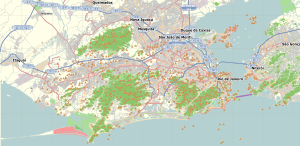
Pelotas is a Brazilian city and municipality (município), the fourth most populous in the southern state of Rio Grande do Sul, after Porto Alegre, Caxias do Sul and Canoas. It is located 270 km (168 mi) from Porto Alegre, the state's capital city, and 130 km (80.8 mi) from the Uruguayan border. The Lagoa dos Patos lies to the east and the São Gonçalo Channel lies to the south, separating Pelotas from the city of Rio Grande.

Bragança Paulista is a municipality in the state of São Paulo in Brazil. The population is 170,533 in an area of 512.6 km². The elevation is 817 m.
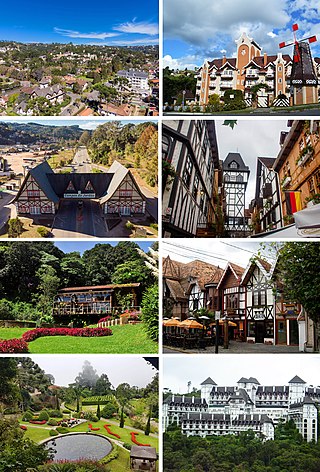
Campos do Jordão is a municipality in the state of São Paulo in southeastern Brazil. It is part of the Metropolitan Region of Vale do Paraíba e Litoral Norte. The population is 52,405 in an area of 290.52 square kilometres (112.17 sq mi). The city is situated 1,628 metres (5,341 ft) above sea level and is the highest city in Brazil.
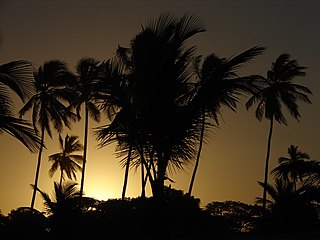
Ilhéus is a major city located in the southern coastal region of Bahia, Brazil, 211 km south of Salvador, the state's capital. The city was founded in 1534 as Vila de São Jorge dos Ilhéus and is known as one of the most important tourism centers of the northeast of Brazil.

Lages is a Brazilian municipality located in the central part of the state of Santa Catarina, in the region known in Portuguese as "Planalto Serrano".
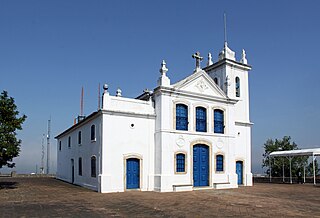
Jacarepaguá, with a land area of 29.27 square miles (75.8 km2), is a neighborhood situated in the West Zone of Rio de Janeiro, Brazil. In 2010, it had a population of 157,326. The name comes from the indigenous name of the location, "shallow pond of caymans", yakaré + upá (pond) + guá (shallow), by the time of the Portuguese colonization.
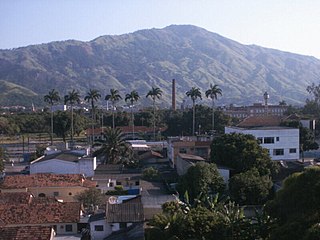
Bangu is a neighborhood in the West Zone of Rio de Janeiro, Brazil. It is a middle-class neighborhood. It is located in the western area of the city being one of the most populated districts, with 244,518 inhabitants [1] distributed in an area of 4570.69 ha. Located in the geographic center of the city, the neighborhood is close to Campo Grande, Senador Camará, Vila Aliança, Padre Miguel and Realengo. On November 22, 2004, the mayor of Rio de Janeiro César Maia created by decree the district Gericinó. The neighborhood was originally part of the neighborhood of Bangu, the region where the penitentiary of Bangu is located, besides Bangu dump. The region is where Gericinó was located containing the sub-district of the Aqueduct. Since 2004, the complex of Bangu and dump of Bangu, no longer belong to the neighborhood of Bangu.

Campo Grande is the largest neighborhood in the West Zone of Rio de Janeiro. Campo Grande has a population of 328,370 inhabitants and an area of 119,1253 sq km, on both counts Rio's largest. It is situated 50 kilometers away from Downtown Rio.

The climate in Brazil varies considerably from mostly tropical north to temperate zones south of the Tropic of Capricorn.

União da Vitória is a municipality in the state of Paraná in Brazil. Its population was about 57,913 people in 2020. In the economic area, União da Vitória's GDP is US$115,364,648.65.
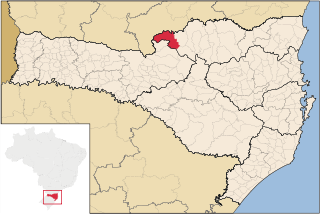
Porto União is a city located in the Northern Plateau in the State of Santa Catarina and on the left bank of Iguazu River, bordering the city of União da Vitória, Paraná. In 2020, its population was estimated in 35,543 inhabitants.
Vila Vintém is an urban low income living community located between the neighbourhoods of Realengo and Padre Miguel, in the West Zone of the city of Rio de Janeiro. Situated on the borders of the railroad, it shelters the headquarters of Mocidade Independente de Padre Miguel and also Unidos de Padre Miguel, as well as many of their components. Its principal road is called Rua Belisário de Souza, that goes from the ensemble of IAPI, in Padre Miguel, until Realengo.

Santa Cruz is an extensive and populous neighborhood of the high class, lower middle and low in the West Zone of the municipality of Rio de Janeiro, Brazil, the farthest from the center of Rio de Janeiro. Cut by the Santa Cruz extension of the urban passenger rail network of the metropolitan region of Rio de Janeiro, it has a very diverse landscape, with commercial areas, residential and industrial.

The Guandu River is a river of Rio de Janeiro state in southeastern Brazil. This river together with the Paraíba do Sul River are the most important in the Rio de Janeiro state.

Patos is a municipality of the state of Paraíba in the Northeast Region of Brazil. It is classified by the Brazilian Institute of Geography and Statistics as a sub-regional center A.
Alto da Boa Vista is a neighborhood in the North Zone of Rio de Janeiro, Brazil.

On the morning of Thursday, 7 April 2011, a World Health Day, 12 children aged between 12 and 14 were killed and 22 others seriously wounded by Wellington Menezes de Oliveira, who entered the Tasso da Silveira Municipal School, an elementary school in Realengo on the western fringe of Rio de Janeiro, Brazil. It was the first non-gang school shooting with a sizable number of casualties reported in Brazil.

Vicente Pires is an administrative region in the Federal District in Brazil. It is bordered by Taguatinga to the west, Águas Claras to the south, Guará to the southeast, Brasília to the north, and Brazlândia to the northwest. According to a 2016 report, Vicente Pires has a population of 72,879. Vicente Pires is the 16th largest administrative region by population. The administrative region was created in 2009 after being separated from Taguatinga via law nº 814/2008, but the area has been occupied since the 1960s.
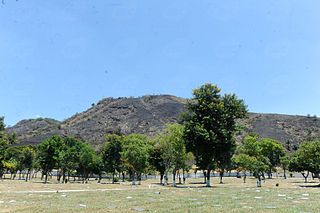
The Pedra Branca State Park is a state park in the state of Rio de Janeiro, Brazil. It is one of the largest urban nature parks in the world. It protects an area of Atlantic Forest in the west of the city of Rio de Janeiro that includes the highest point in the city, the Pico da Pedra Branca.

Rio de Janeiro is on the far western part of a strip of Brazil's Atlantic coast, close to the Tropic of Capricorn, where the shoreline is oriented east–west. Facing largely south, the city was founded on an inlet of this stretch of the coast, Guanabara Bay, and its entrance is marked by a point of land called Sugar Loaf – a "calling card" of the city.

